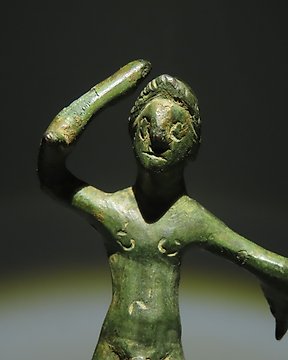
Etruscan Bronze Figurine d'Héraclès. 6ème siècle avant JC. 7 cm de haut.
Nº 82683069

Nº 82683069

Important Bracelet
Etruscan, 5th century BC.
Golden Copper
8.8 cm D. Weight of 27 grams
Condition: Good condition. It presents internal breaks in the metal body that have caused the breakage of the gold plating.
Provenance: Private collection of the heirs of Mr. Nabon, Vendome, France. 1960 - 1970.
Description:
This bracelet from the Etruscan culture is remarkable for its beautiful decorative pattern: the heads of two reptiles face each other at the ends, while the two animals share a single scaled body. This piece reflects the high technical level adopted by Etruscan craftsmen in the 5th century BC. Etruscan artists were highly skilled craftsmen. They produced pieces (statues, ceramics, mirrors, boxes, etc.) of great quality and mastery in terracotta, tufa, clay, bronze, etc. They also developed pieces of jewellery. They also developed pieces of jewellery (in gold, silver and ivory) and a black pottery called bucchero. In the "Museo Archeologico Nazionale Etrusco della Città di Chiusi" you can see numerous funerary urns, vases decorated with black figures and bucchero pottery, as well as bronze statuettes. Some 600 terracotta and alabaster funerary urns can also be seen in the Museo Guarnacci in Volterra.
Etruscan art is often of a religious nature and is therefore related to the demands of the Etruscan religion. The Etruscan afterlife was negative, unlike the positive view of ancient Egypt where it was a continuation of earthly life, or the trusting relationships with the gods of ancient Greece. The Etruscan gods were indifferent and tended to bring good luck, so Etruscan religion was centred on their veneration and the worship of the dead. Most of the remains of Etruscan art are found in cemetery excavations (as in Cerveteri, Tarquinia, Populonia, Orvieto, Vetulonia, Norchia), which means that we see Etruscan art dominated by representations of religion and in particular the funerary cult.
NOTES:
The Seller can prove that the lot was obtained legally , provenance statement seen by Catawiki.
Important information. The seller guarantees that he is entitled to ship this lot.
- The piece includes authenticity certificate.
- The piece includes Spanish Export License.
- The seller guarantees that he acquired this piece according to all national and international laws related to the ownership of cultural property.
THE MINISTRY OF CULTURE FROM SPAIN ASKS ALL SELLERS FOR INVOICES OR OTHER DOCUMENTATION ABLE TO PROVE THE LEGALITY OF EACH ITEM BEFORE PROVIDING AN IMPORT OR EXPORT LICENSE.
Comment acheter sur Catawiki ?
1. Découvrez des objets d’exception
2. Faites la meilleure offre
3. Effectuez un paiement sécurisé